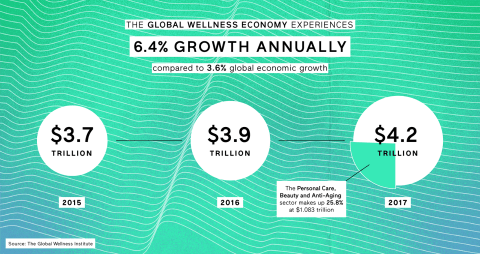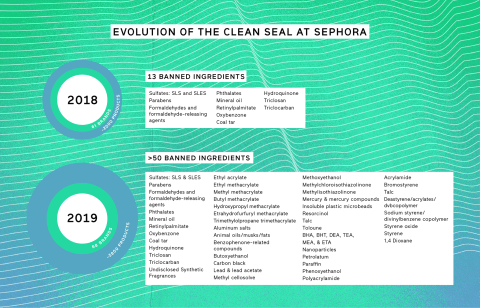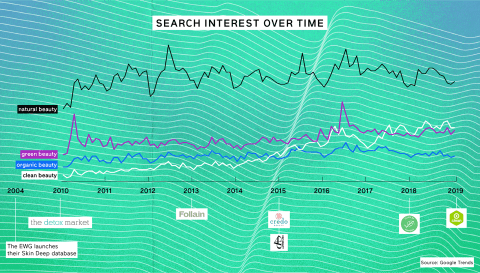But in the last year, it’s also become the unlikely home to another beauty consumer and brand: The kind that cross-references the Environmental Working Group’s website on a regular basis and whose routine defaults to less is more. Sephora, in what seemed nearly unthinkable only a few years prior, became a clean beauty hub—if not the go-to clean retailer for many. But by the time they launched their clean section last year—which included a verified stamp of approval, designated section on the website, and an official list of nasties—things had changed. What was different this time around? “Wellness” had entered the mainstream in a way that was clearly not a passing fad. According to the Global Wellness Institute, a registered 501(c)(3) nonprofit, the global wellness-related economy was at about $4.2 trillion in 2017 (they define said market as including nutrition, fitness, personal care products, well-being-centered tourism, and so on.) Not only that, but it’s grown by 6.4% annually from 2015, which is nearly twice as fast as global economic growth as a whole. In the seal’s first iteration, they nixed 13 ingredients, like SLS and SLES, parabens, formaldehydes and formaldehyde-releasing agents, and phthalates. While overall the feedback was widely positive, there was criticism from clean beauty enthusiasts that they felt it didn’t go far enough. “There’s a lot of voices in this space, and there’s a lot of opinions about what clean should mean,” says Deily. “So we were prepared for both positive and negative feedback. We went into it with the full acknowledgment that we weren’t done, and we were going to keep evolving it.” She notes they were talking to third-party experts—clean brands, the EWG, cosmetic chemists, toxicologists, European ingredient experts—and decided to expand their list accordingly the following year. So this summer, in July of 2019, they made their biggest investment in green beauty to date and relaunched their seal in a major way, from 13 “no” ingredients to over 50, including BHA (Butylated hydroxyanisole), carbon black, mercury, aluminum salts, lead, and toluene. Not only was it a signal that consumers were looking for higher standards, but it was a signal that this time around their clean campaign had staying power—it was deserving of more investment and more attention to detail. “We went back and really thought about what was needed to improve the Seal; we wanted to make sure that if some people didn’t trust us before, they would now,” says Deily. You only double-down when you’re confident of the outcome. At the onset, there were 61 brands (with around 2,000 products) under the clean umbrella. Now, there are 68 (and around 2,800 products), according to Sephora. Most of the brands under Sephora’s clean umbrella were formulated clean from their inception and didn’t need any reformulations or change their brand messaging. But having the seal and designated space has made them more prominent to clean and clean-curious consumers. Recognition is perhaps the biggest draw for clean brands—instead of being lost in a sea of products on a website, there’s a big green stamp to call attention to it. “Sephora has the recognition, authority, and reach that a smaller, indie brand would never have been able to match on our own at this stage,” says Mina Chae, director of marketing and consumer engagement at Farmacy. “In the past few months alone, when I’ve introduced Farmacy in conversation, people will say ‘Isn’t Farmacy a clean brand at Sephora?’ and suddenly there’s this immediate understanding of what our brand stands for.” They’re also helping launch natural and clean brands. Take, for example, Together Beauty, a natural hair care line that launched exclusively at Sephora earlier this year. “We were sitting around a table with a dozen Sephora employees at their headquarters before our launch—trust me; they go through everything and have no mercy—and when they say you’ve created something functional, you know you’re good. I call them the Gods at Sephora; it is such a sophisticated operation,” founder Sam Brocato told me at the time of their launch. “We’re going to get much larger reach than we ever would have otherwise.” But what’s more surprising is the coming and rumored reformulations. “These are happening across a pretty significant number of brands right now,” says Deily. “It also happened in the background of the initial launch of Clean at Sephora as well as the relaunch. We gave the brands about a year’s notice for our new standards, and several dozen sku’s [stock keeping units] were reformulated in that time. Even now, there are a few brands that are working on sweeping reformulations so they can qualify and some brands you’d probably never expect.” She’s not the only one to say this. Anecdotally, other brand founders have mentioned the appeal of Sephora’s seal within the beauty industry and how unlikely characters are now eyeing it. “One of the biggest trends we’ll see in the industry in the coming years is people going for this seal,” says Rose-Marie Swift, founder of clean makeup and skin care brand RMS Beauty. “I have heard from many in the industry that they want this seal, and they’re looking to reformulate to do it.” Catherine Gore, president of clean skin care brand Biossance, noted similarly, “Many brands are reformulating to meet the rising consumer demand for effective, clean products that don’t compromise your health or that of the planet, and we think this is great.” Of course, there were and are many clean retailers already—amassing a base in their own right. There’s Credo Beauty, who now has nine brick-and-mortar stores across the country, with another on the way and possibly more down the line. Whole Foods Market’s reps said earlier this year that they intend to make the grocery chain a clean beauty destination. Just this month, a brand-new online retailer named NakedPoppy launched. These tend to be more selective or strict with their offerings: For example, Credo’s list is considered one of the most robust in the industry and painstakingly details every ingredient and why it’s avoided in their products. NakedPoppy has an in-house clean ingredient expert to personally evaluate each and every ingredient that goes into every product listed on their site. Whole Foods Market bans over 100 ingredients in their personal and body care products. So how are they dealing with the newfound competition? “We think it is an incredibly positive direction to see mass retail committing to putting safer products on their shelves. When these companies identify chemicals of concern and raise awareness with the kind of reach that they have, it further pushes contract manufacturers to start formulating with better ingredients, and it pushes big brands to start making changes,” says Annie Jackson, Credo co-founder and COO. “It also raises awareness in customers’ eyes—they know there are better options out there without sacrificing. We knew eventually this would become a way of life versus a trend.” Ultimately, there’s still a major difference between mass-market clean and these clean-only retailers: the value placement. Clean-only retailers are often mission-driven; they have a point of view, and all their decisions are made through this lens. They can, and do, make a judgment call. “Clean beauty is why we exist, so it shapes everything from our stores, our staff, our website, and the way we interact with our customers,” says Jackson. “It’s a belief in a holistic vision for what beauty is: looking good and feeling good.” Sephora, on the other hand, offers their clean products as simply another alternative to their many, many others. It’s an acknowledgment of something that was no longer ignorable, not necessarily an endorsement. “We just want to make our site and stores easy to shop,” says Deily. “We are certainly not making a judgment on whether clean is better or not. We just wanted our consumers to know that, first, the products are there. And second, make sure they don’t have to do all the research by themselves.” But, just perhaps, this approach is what made it so enticing and accessible for the mass market. It showed that you can do clean and not-so-clean side-by-side—without one negating the other. After all, I think that’s how many of us live our lives: Eat organic and fast food. Do yoga and also spend all day on the sofa if the occasion calls for it. Practice mindfulness and mindlessly scroll social media. Well-being isn’t black and white. “The area that we are spending an enormous amount of time and energy on is sustainability. We are looking at how the products are being packaged, manufactured, what does the supply chain look like,” says Deily. “These are separate from clean but certainly related. It’s not something we want to be exclusive in our approach to. A clean and non-clean brand can be sustainable. It’s all still in the works, but it is top of mind for a lot of cosmetic companies—and something that the beauty industry desperately needs to address, and rather quickly.”







